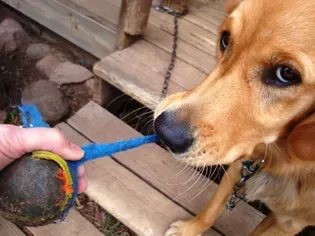How to Make a Dog Throw Up (And When You Shouldn't)
Updated on 04/26/24

[How to Make a Dog Throw Up (And When You Shouldn't)]
Introduction:
As devoted dog owners, we cherish our canine companions like family members. However, certain situations may arise where inducing vomiting becomes necessary for their well-being. Whether it's an accidental ingestion of something toxic or an attempt to relieve discomfort from gastrointestinal distress, understanding how and when to make a dog throw up is crucial. This comprehensive guide will provide you with the necessary knowledge to make an informed decision and guide you through the process safely and effectively.
Determining When to Induce Vomiting:
Before attempting to induce vomiting, it's essential to carefully assess the situation and determine whether it's genuinely necessary. Consult your veterinarian immediately if you suspect your dog has ingested a poisonous substance or if it's exhibiting severe symptoms such as seizures, difficulty breathing, or excessive drooling.
Consider inducing vomiting if your dog has:
* Ingested a small amount of a toxic substance, such as rat poison or antifreeze.
* Eaten a foreign object, such as a toy or a piece of fabric.
* Consumed spoiled or contaminated food.
* Displayed symptoms of gastrointestinal distress, including vomiting, diarrhea, and abdominal pain.
Methods of Inducing Vomiting:
Once you've determined that inducing vomiting is necessary, several methods can be employed to achieve the desired result. However, it's important to note that each method has its own potential risks and considerations.
1. Hydrogen Peroxide (3%):
* Administer 1 teaspoon of 3% hydrogen peroxide per 5-10 pounds of body weight orally.
* Repeat the dose if vomiting does not occur within 15 minutes, but do not exceed three doses.
* Hydrogen peroxide can cause irritation of the esophagus and stomach lining, so it should not be used on dogs with underlying gastrointestinal issues.
2. Ipecac Syrup:
* Administer 1 milliliter of ipecac syrup per 2 pounds of body weight orally.
* Repeat the dose if vomiting does not occur within 15 minutes, but do not exceed three doses.
* Ipecac syrup can cause drowsiness, lethargy, and cardiac arrhythmias in some dogs, so it should be used with caution.
3. Salt Water:
* Dissolve 1-2 tablespoons of salt in a cup of warm water.
* Administer the solution orally to your dog.
* Salt water can cause dehydration, so it should not be used on dogs with underlying kidney or heart conditions.
4. Apomorphine Injections:
* Apomorphine injections are a prescription medication that can be administered by a veterinarian to induce vomiting.
* This method is typically recommended for cases where other methods have been unsuccessful or when the dog is unable to cooperate with the administration of oral solutions.
Precautions and Considerations:
* Do not induce vomiting if your dog is unconscious or has difficulty breathing.
* Do not induce vomiting if your dog has ingested a corrosive substance, such as bleach or drain cleaner.
* Do not induce vomiting if your dog has a history of seizures or heart conditions.
* If vomiting does not occur within 15 minutes of administering the first dose, do not give another dose.
* Monitor your dog closely after inducing vomiting for any signs of distress or complications.
* Contact your veterinarian immediately if your dog continues to vomit excessively, has difficulty breathing, or shows signs of dehydration.
When Not to Induce Vomiting:
While inducing vomiting can be a helpful technique in certain situations, there are instances where it's strongly advised against.
* Do not induce vomiting if your dog has ingested a sharp object, such as a needle or piece of glass.
* Do not induce vomiting if your dog has ingested a large amount of a toxic substance.
* Do not induce vomiting if your dog is weak, lethargic, or unresponsive.
* Do not induce vomiting if your dog has a history of esophageal or stomach ulcers.
Conclusion:
Understanding how and when to induce vomiting in dogs is an essential part of responsible pet ownership. By carefully assessing the situation, selecting the appropriate method, and following the necessary precautions, you can safely and effectively assist your furry friend in cases of accidental ingestion or gastrointestinal distress. Always remember to consult your veterinarian promptly if you have any concerns or if your dog's condition worsens after inducing vomiting. By taking proactive measures, you can ensure your dog's well-being and create a long and healthy bond together.
Explore More Pets

Basic Training
Puppy and Baby Introductions

Working Dog Breeds
All About Search and Rescue Dogs

Dog Treatments
Puppy Vaginitis: Signs, Causes and Treatment

Dog Adoption
After More Than 1,200 Days in the Shelter, Coco Goes Home

Basic Training
How to Train Your Puppy to Go on Potty Pads

Hybrid Dog Breeds
The Difference Between a Mutt, Mixed Breed, or Designer Dog?

Dog Treatments
Nail Problems in Dogs

Puppies
7 Reasons Why Two Dogs Are Better Than One